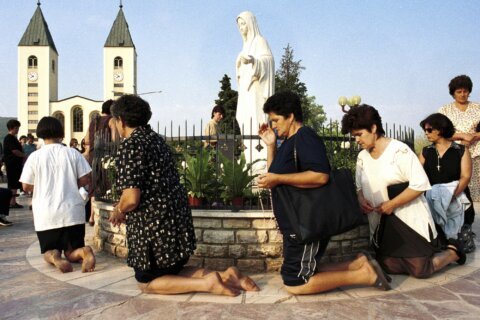As the U.S. faces a growing doctor shortage, medical schools are struggling to meet the shortfall. They’re also struggling to matriculate student bodies that reflect the nation’s racial diversity — so while the shortage of doctors is grave, it’s even worse with underrepresented minorities.
According to the Association of American Medical Colleges, Hispanic people represent 18.5% of the U.S. population, but only 5.8% of doctors; Black people make up 13.4% of the population, but 5% of doctors; and Native Americans and Alaska Natives are 1.3% of the U.S. population, but just .3% of doctors.
For medical schools, AAMC data indicates that Black or African American students made up 10% of total matriculants in 2023-24, down from 10.2% in 2022-23; matriculants of Hispanic, Latino or Spanish origin comprised 12.7% of total matriculants in 2022-23, up from 12.3% the previous year; and Native American or Alaska Native students made up 1.1% of total matriculants in 2022-23, up from 1% in 2021-22.
While that data suggests enrollment growth among some underrepresented groups, barriers to medical school persist for many minority students. Recognizing that increased diversity among doctors leads to better health and health equity, the AAMC calls significantly increasing diversity among med school students “a core strategic priority.”
Experts say racial similarity between patients and doctors — for example, Black patients being treated by Black doctors — can improve overall trust, quality of care and health outcomes. Experts say more doctors from underrepresented racial minorities can help address health care gaps for those populations.
[Related:What Premeds Should Know About Types of Doctors]
“I think this is a huge effort for many medical schools,” says Dr. Denise Martinez, associate dean of diversity, equity and inclusion and a health sciences clinical professor at the University of California–Riverside School of Medicine. “But these efforts are not completely favored by all right now; there’s some real challenges related to that. I think some schools will persist and some schools might not in the same way because of those challenges.”
The U.S. Supreme Court’s decision in 2023 that declared it unconstitutional for colleges to consider race in admissions won’t help efforts to boost the ranks of doctors from underrepresented minority groups, many observers say.
Why and Where Access Barriers Exist
For underrepresented minorities, experts say the list of barriers to medical school admission includes:
— Limited exposure to careers in medicine.
— Poor advising and greater discouragement from academic advisers, compared with white students.
— Lack of familiarity with the medical school application process.
— Fewer opportunities for medical volunteerism, clinical shadowing, extracurricular activities, mentorship and internships.
— Lack of diversity in medical school admissions committees and faculty.
— Financial obstacles, including the high cost of medical school along with undergraduate debt.
— Parental income and educational background.
— Inability to pay for Medical College Admission Test prep classes or the exam.
— Poor academic preparation for college.
“If you’re not in schools that are preparing you well enough to get into medical school and the rigors of premedical coursework, that can be a huge challenge,” Martinez says.
Experts say medical schools’ emphasis on undergraduate GPA and MCAT results creates another barrier for underrepresented minorities, and reassessing the weight of MCAT scores in admissions could help diversify med school classes.
While there’s long been a correlation between strong MCAT performance and medical school success, there’s also evidence that most students with midrange MCAT scores succeed in medical school. But those students are often overlooked in favor of students with higher scores.
[Read: How Hard Is Medical School and What Is the Med School Curriculum?]
On average, Asian and white students apply to medical school with higher GPAs and MCAT scores compared to Black and Hispanic or Latino applicants.
“We know one of the highest correlations to whether or not somebody does well on the entrance exams to medical school is actually parental income,” Martinez says. “There is disparity in parental income for certain groups, which have made MCAT scores historically a little bit lower.”
Some organizations, such as the AAMC, offer free MCAT prep resources.
How Schools Are Breaking Access Barriers
To boost racial diversity and help underrepresented minority students toward a career in medicine, medical schools are increasingly using accelerated pathway programs. Some focus on early exposure to health care careers and academic preparation for K-12 students while others streamline the path from a bachelor’s degree to a medical degree.
Students in the seven-year Sophie Davis Biomedical Education Program at CUNY School of Medicine in New York, for example, complete a bachelor’s in biomedical sciences in three years and are then eligible to enroll in the four-year medical program.
CUNY School of Medicine’s in-state full-time students pay roughly $7,000 per year for their bachelor’s degree, then $41,600 per year for medical school — both lower than national averages — and the MCAT is not required for admission. The school is in Harlem, which is designated a Health Professional Shortage Area (HPSA) by the federal government, and its dual mission is to make medical school accessible to students who have been historically underrepresented in medicine, and train future doctors committed to practicing in high-need communities.
Studies have indicated that just the presence of doctors of color can have positive health benefits for patients of color. Other factors such as language and religious and cultural similarities between doctors and patients significantly increase patient trust, says Dr. Carmen Green, dean of the CUNY School of Medicine.
CUNY’s program has a residency match rate of almost 100%, with 75% of graduates staying and working in metro New York City and 37% working in HPSAs.
“I’d much rather take our chances — and we do really well by taking our chances — and spend the time and energy on learning the students who are going to make a difference,” Green says. “Our motto has really been about equity, access and inclusion. We’ve shown through our work that we can address educational disparities. Our next goal is to eliminate health care disparities.”
Some pathway programs partner with local school districts to provide medical education and hands-on learning to high school, middle school and elementary school students, as well as opportunities for clinical and job-shadowing experiences that can “demystify the process,” Martinez says.
Pathway programs at UC-Riverside include 10 variations that prepare students — high school through post-baccalaureate — for careers in medicine and health, with the aim of increasing diversity in the inland Southern California health care workforce.
The school’s Thomas Haider Early Assurance Program provides a guaranteed spot in a future medical school class to “mission-fit” undergraduate students or recent graduates who “demonstrate strong academic ability, significant clinical and volunteer experience, and a demonstrated commitment to practice medicine in Inland Southern California,” according to its website.
[Related:How Long Is Medical School and What Is It Like?]
Students in this pathway program are admitted into the school of medicine after one year, no MCAT score required. Students who apply for general admission, on the other hand, are required to submit an MCAT score, but Martinez says the school is mostly focused on whether students are a good fit for the program.
Students who want to serve underserved communities often come from those communities, she says, and to help break the cost barrier, the school offers full-ride scholarships with an agreement that recipients commit to practicing five years ,within the region after graduating.
“It’s usually a win-win because a lot of these students would want to be here anyway,” she says. “But it makes sure that we’re selecting the right types of students — students who come from underrepresented backgrounds, but also other backgrounds who might be committed to us and our community that is very diverse.”
UC-Riverside also offers the Program in Medical Education, which aims to train doctors specifically to address health care needs of Black, African and Caribbean communities of inland Southern California.
Other U.S. med schools are making similar efforts, and Martinez says her own experience is one success story among many: She was the first in her family to become a doctor.
“I was a person who was in a pathway program after being told by a premedical adviser that I would never be a doctor,” she says. But the program “literally changed the trajectory of my life. These types of efforts actually do work. They are vital and critical for serving the needs of our greater community.”
More from U.S. News
The Medical School Admissions Cycle: A Month-by-Month Guide
Most Common Reasons Medical School Applicants Get Rejected
How to Make Up for Medical School Application Deficiencies
How Medical Schools Are Improving Access for Underrepresented Minorities originally appeared on usnews.com







